Postpartum Depression: Causes and Treatment
VerifiedAdded on 2020/03/07
|11
|2960
|41
AI Summary
This assignment delves into the multifaceted issue of postpartum depression (PPD), examining its underlying causes, ranging from hormonal shifts to social pressures, and exploring various treatment options available to support new mothers experiencing PPD. The provided resources encompass scholarly articles discussing risk factors, interventions like interpersonal psychotherapy, and the impact of PPD on mother-infant interactions and child development. Understanding these aspects is crucial for promoting maternal mental well-being and providing effective care.
Contribute Materials
Your contribution can guide someone’s learning journey. Share your
documents today.
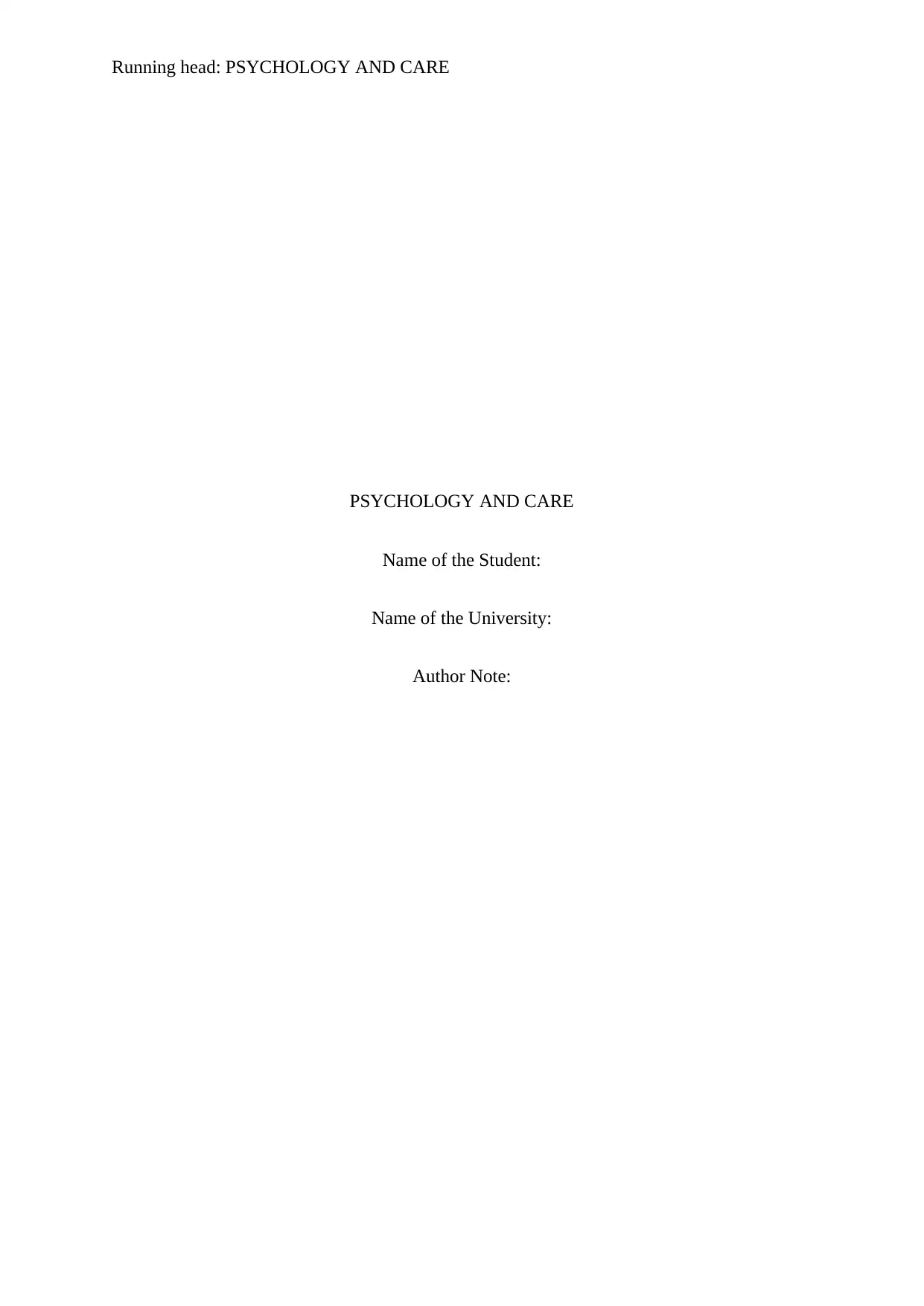
Running head: PSYCHOLOGY AND CARE
PSYCHOLOGY AND CARE
Name of the Student:
Name of the University:
Author Note:
PSYCHOLOGY AND CARE
Name of the Student:
Name of the University:
Author Note:
Secure Best Marks with AI Grader
Need help grading? Try our AI Grader for instant feedback on your assignments.
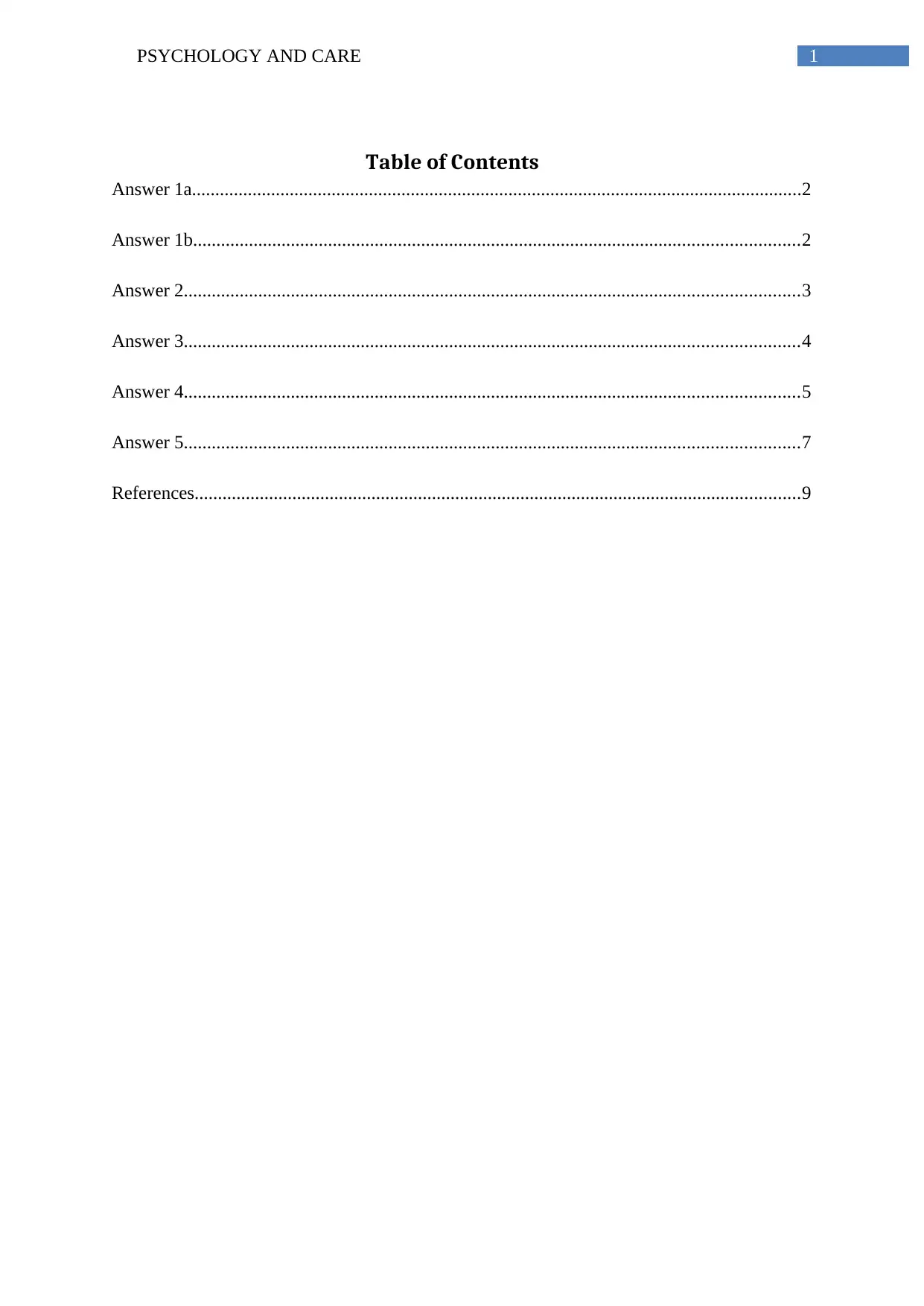
1PSYCHOLOGY AND CARE
Table of Contents
Answer 1a...................................................................................................................................2
Answer 1b..................................................................................................................................2
Answer 2....................................................................................................................................3
Answer 3....................................................................................................................................4
Answer 4....................................................................................................................................5
Answer 5....................................................................................................................................7
References..................................................................................................................................9
Table of Contents
Answer 1a...................................................................................................................................2
Answer 1b..................................................................................................................................2
Answer 2....................................................................................................................................3
Answer 3....................................................................................................................................4
Answer 4....................................................................................................................................5
Answer 5....................................................................................................................................7
References..................................................................................................................................9
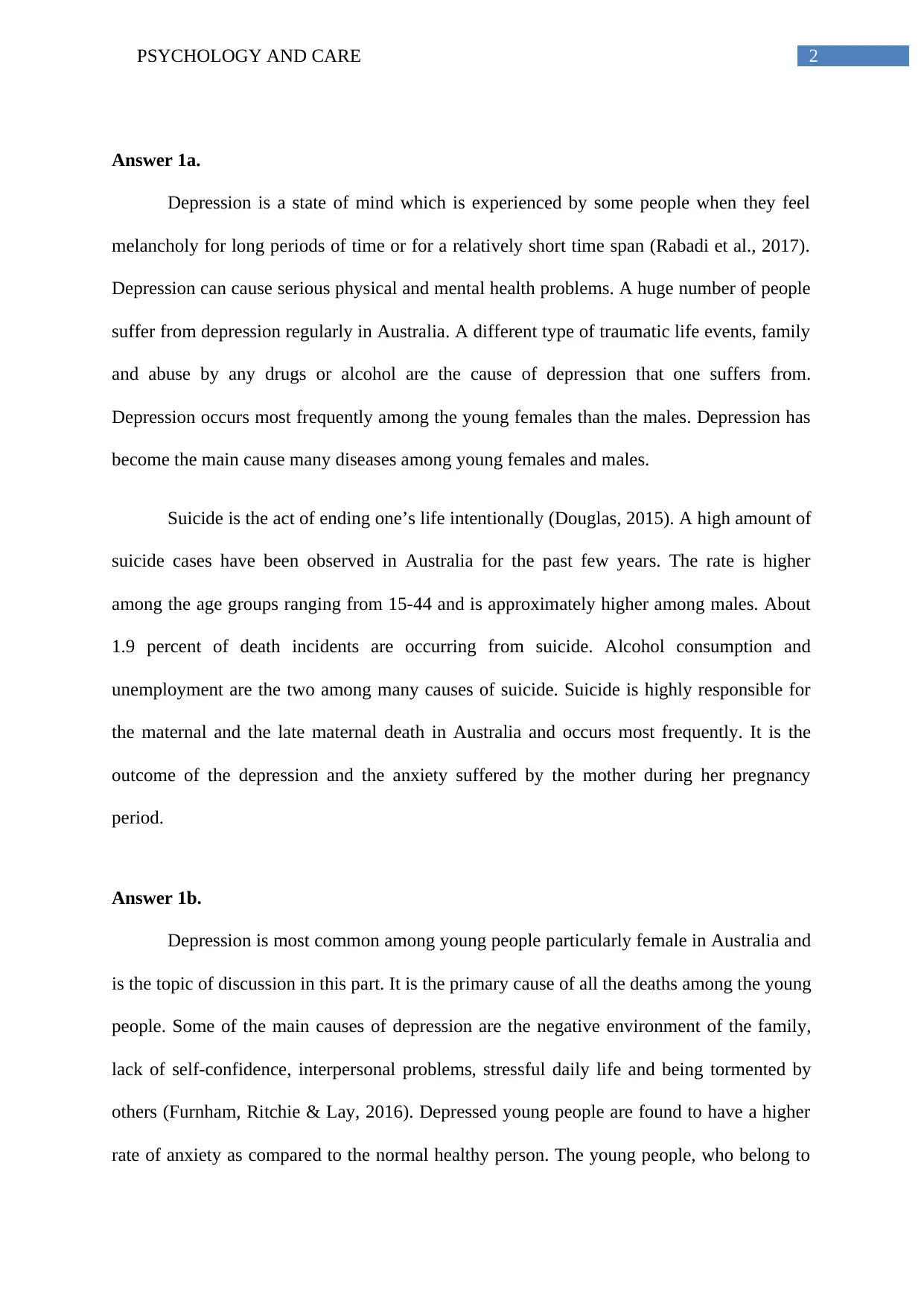
2PSYCHOLOGY AND CARE
Answer 1a.
Depression is a state of mind which is experienced by some people when they feel
melancholy for long periods of time or for a relatively short time span (Rabadi et al., 2017).
Depression can cause serious physical and mental health problems. A huge number of people
suffer from depression regularly in Australia. A different type of traumatic life events, family
and abuse by any drugs or alcohol are the cause of depression that one suffers from.
Depression occurs most frequently among the young females than the males. Depression has
become the main cause many diseases among young females and males.
Suicide is the act of ending one’s life intentionally (Douglas, 2015). A high amount of
suicide cases have been observed in Australia for the past few years. The rate is higher
among the age groups ranging from 15-44 and is approximately higher among males. About
1.9 percent of death incidents are occurring from suicide. Alcohol consumption and
unemployment are the two among many causes of suicide. Suicide is highly responsible for
the maternal and the late maternal death in Australia and occurs most frequently. It is the
outcome of the depression and the anxiety suffered by the mother during her pregnancy
period.
Answer 1b.
Depression is most common among young people particularly female in Australia and
is the topic of discussion in this part. It is the primary cause of all the deaths among the young
people. Some of the main causes of depression are the negative environment of the family,
lack of self-confidence, interpersonal problems, stressful daily life and being tormented by
others (Furnham, Ritchie & Lay, 2016). Depressed young people are found to have a higher
rate of anxiety as compared to the normal healthy person. The young people, who belong to
Answer 1a.
Depression is a state of mind which is experienced by some people when they feel
melancholy for long periods of time or for a relatively short time span (Rabadi et al., 2017).
Depression can cause serious physical and mental health problems. A huge number of people
suffer from depression regularly in Australia. A different type of traumatic life events, family
and abuse by any drugs or alcohol are the cause of depression that one suffers from.
Depression occurs most frequently among the young females than the males. Depression has
become the main cause many diseases among young females and males.
Suicide is the act of ending one’s life intentionally (Douglas, 2015). A high amount of
suicide cases have been observed in Australia for the past few years. The rate is higher
among the age groups ranging from 15-44 and is approximately higher among males. About
1.9 percent of death incidents are occurring from suicide. Alcohol consumption and
unemployment are the two among many causes of suicide. Suicide is highly responsible for
the maternal and the late maternal death in Australia and occurs most frequently. It is the
outcome of the depression and the anxiety suffered by the mother during her pregnancy
period.
Answer 1b.
Depression is most common among young people particularly female in Australia and
is the topic of discussion in this part. It is the primary cause of all the deaths among the young
people. Some of the main causes of depression are the negative environment of the family,
lack of self-confidence, interpersonal problems, stressful daily life and being tormented by
others (Furnham, Ritchie & Lay, 2016). Depressed young people are found to have a higher
rate of anxiety as compared to the normal healthy person. The young people, who belong to
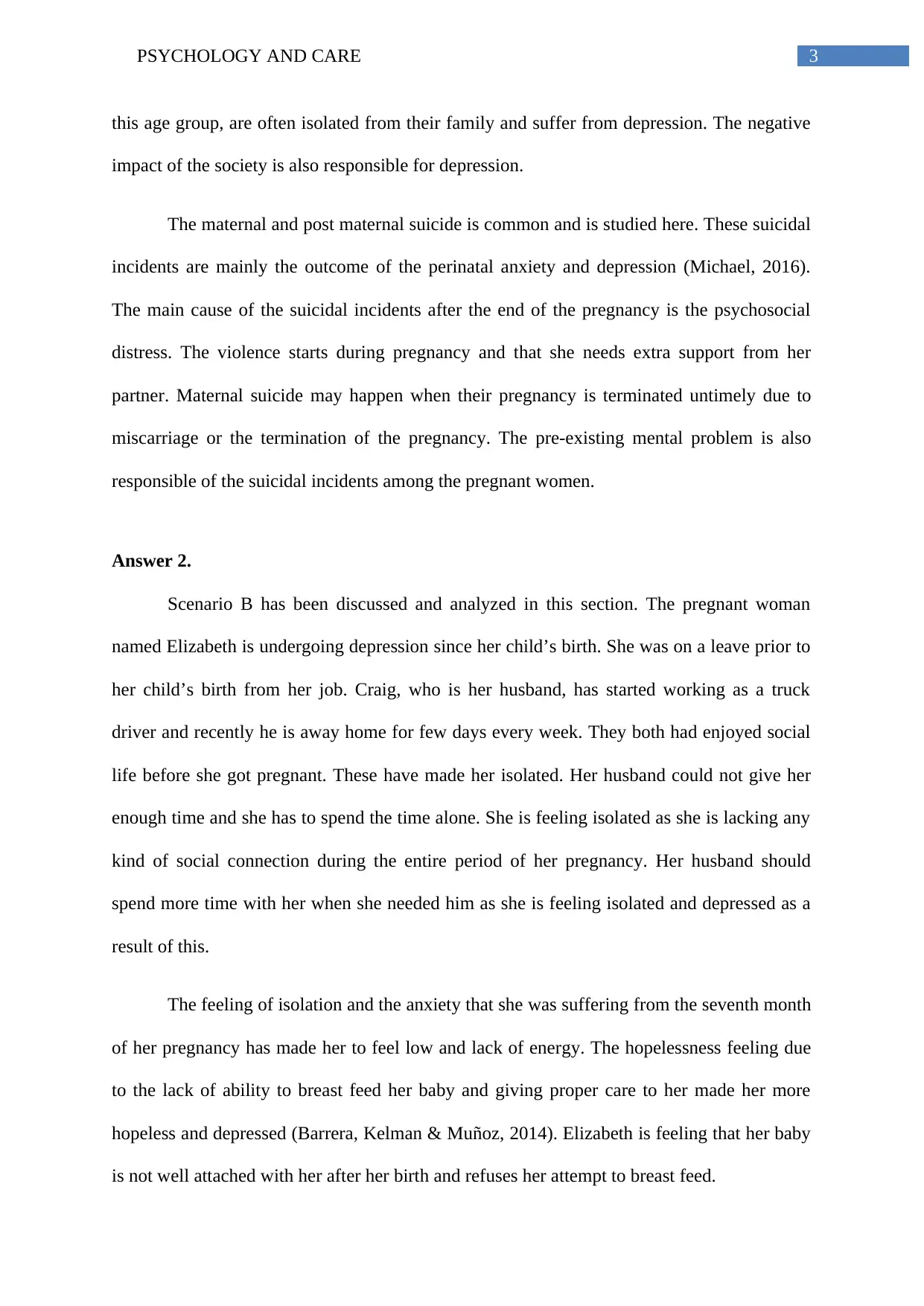
3PSYCHOLOGY AND CARE
this age group, are often isolated from their family and suffer from depression. The negative
impact of the society is also responsible for depression.
The maternal and post maternal suicide is common and is studied here. These suicidal
incidents are mainly the outcome of the perinatal anxiety and depression (Michael, 2016).
The main cause of the suicidal incidents after the end of the pregnancy is the psychosocial
distress. The violence starts during pregnancy and that she needs extra support from her
partner. Maternal suicide may happen when their pregnancy is terminated untimely due to
miscarriage or the termination of the pregnancy. The pre-existing mental problem is also
responsible of the suicidal incidents among the pregnant women.
Answer 2.
Scenario B has been discussed and analyzed in this section. The pregnant woman
named Elizabeth is undergoing depression since her child’s birth. She was on a leave prior to
her child’s birth from her job. Craig, who is her husband, has started working as a truck
driver and recently he is away home for few days every week. They both had enjoyed social
life before she got pregnant. These have made her isolated. Her husband could not give her
enough time and she has to spend the time alone. She is feeling isolated as she is lacking any
kind of social connection during the entire period of her pregnancy. Her husband should
spend more time with her when she needed him as she is feeling isolated and depressed as a
result of this.
The feeling of isolation and the anxiety that she was suffering from the seventh month
of her pregnancy has made her to feel low and lack of energy. The hopelessness feeling due
to the lack of ability to breast feed her baby and giving proper care to her made her more
hopeless and depressed (Barrera, Kelman & Muñoz, 2014). Elizabeth is feeling that her baby
is not well attached with her after her birth and refuses her attempt to breast feed.
this age group, are often isolated from their family and suffer from depression. The negative
impact of the society is also responsible for depression.
The maternal and post maternal suicide is common and is studied here. These suicidal
incidents are mainly the outcome of the perinatal anxiety and depression (Michael, 2016).
The main cause of the suicidal incidents after the end of the pregnancy is the psychosocial
distress. The violence starts during pregnancy and that she needs extra support from her
partner. Maternal suicide may happen when their pregnancy is terminated untimely due to
miscarriage or the termination of the pregnancy. The pre-existing mental problem is also
responsible of the suicidal incidents among the pregnant women.
Answer 2.
Scenario B has been discussed and analyzed in this section. The pregnant woman
named Elizabeth is undergoing depression since her child’s birth. She was on a leave prior to
her child’s birth from her job. Craig, who is her husband, has started working as a truck
driver and recently he is away home for few days every week. They both had enjoyed social
life before she got pregnant. These have made her isolated. Her husband could not give her
enough time and she has to spend the time alone. She is feeling isolated as she is lacking any
kind of social connection during the entire period of her pregnancy. Her husband should
spend more time with her when she needed him as she is feeling isolated and depressed as a
result of this.
The feeling of isolation and the anxiety that she was suffering from the seventh month
of her pregnancy has made her to feel low and lack of energy. The hopelessness feeling due
to the lack of ability to breast feed her baby and giving proper care to her made her more
hopeless and depressed (Barrera, Kelman & Muñoz, 2014). Elizabeth is feeling that her baby
is not well attached with her after her birth and refuses her attempt to breast feed.
Secure Best Marks with AI Grader
Need help grading? Try our AI Grader for instant feedback on your assignments.
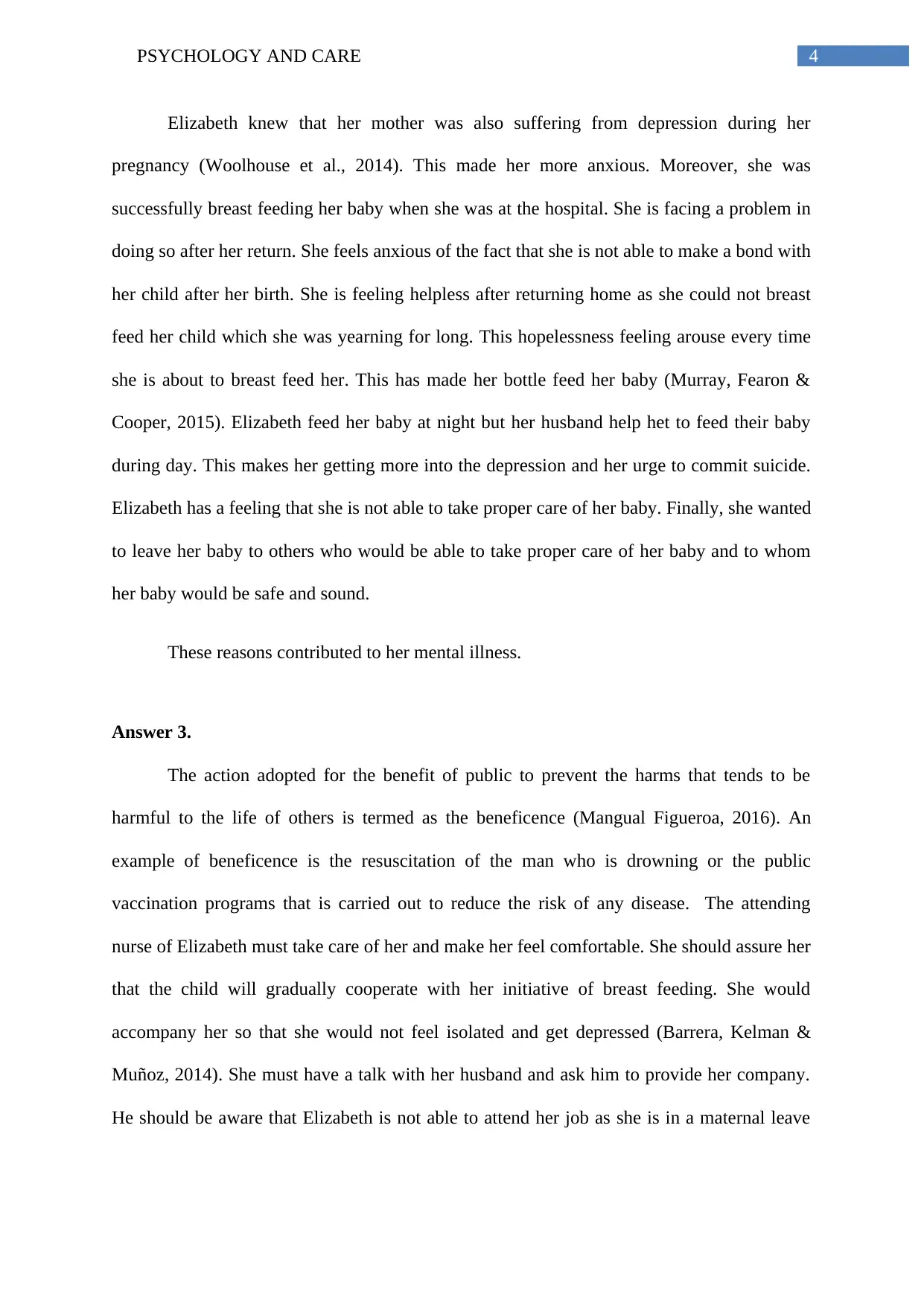
4PSYCHOLOGY AND CARE
Elizabeth knew that her mother was also suffering from depression during her
pregnancy (Woolhouse et al., 2014). This made her more anxious. Moreover, she was
successfully breast feeding her baby when she was at the hospital. She is facing a problem in
doing so after her return. She feels anxious of the fact that she is not able to make a bond with
her child after her birth. She is feeling helpless after returning home as she could not breast
feed her child which she was yearning for long. This hopelessness feeling arouse every time
she is about to breast feed her. This has made her bottle feed her baby (Murray, Fearon &
Cooper, 2015). Elizabeth feed her baby at night but her husband help het to feed their baby
during day. This makes her getting more into the depression and her urge to commit suicide.
Elizabeth has a feeling that she is not able to take proper care of her baby. Finally, she wanted
to leave her baby to others who would be able to take proper care of her baby and to whom
her baby would be safe and sound.
These reasons contributed to her mental illness.
Answer 3.
The action adopted for the benefit of public to prevent the harms that tends to be
harmful to the life of others is termed as the beneficence (Mangual Figueroa, 2016). An
example of beneficence is the resuscitation of the man who is drowning or the public
vaccination programs that is carried out to reduce the risk of any disease. The attending
nurse of Elizabeth must take care of her and make her feel comfortable. She should assure her
that the child will gradually cooperate with her initiative of breast feeding. She would
accompany her so that she would not feel isolated and get depressed (Barrera, Kelman &
Muñoz, 2014). She must have a talk with her husband and ask him to provide her company.
He should be aware that Elizabeth is not able to attend her job as she is in a maternal leave
Elizabeth knew that her mother was also suffering from depression during her
pregnancy (Woolhouse et al., 2014). This made her more anxious. Moreover, she was
successfully breast feeding her baby when she was at the hospital. She is facing a problem in
doing so after her return. She feels anxious of the fact that she is not able to make a bond with
her child after her birth. She is feeling helpless after returning home as she could not breast
feed her child which she was yearning for long. This hopelessness feeling arouse every time
she is about to breast feed her. This has made her bottle feed her baby (Murray, Fearon &
Cooper, 2015). Elizabeth feed her baby at night but her husband help het to feed their baby
during day. This makes her getting more into the depression and her urge to commit suicide.
Elizabeth has a feeling that she is not able to take proper care of her baby. Finally, she wanted
to leave her baby to others who would be able to take proper care of her baby and to whom
her baby would be safe and sound.
These reasons contributed to her mental illness.
Answer 3.
The action adopted for the benefit of public to prevent the harms that tends to be
harmful to the life of others is termed as the beneficence (Mangual Figueroa, 2016). An
example of beneficence is the resuscitation of the man who is drowning or the public
vaccination programs that is carried out to reduce the risk of any disease. The attending
nurse of Elizabeth must take care of her and make her feel comfortable. She should assure her
that the child will gradually cooperate with her initiative of breast feeding. She would
accompany her so that she would not feel isolated and get depressed (Barrera, Kelman &
Muñoz, 2014). She must have a talk with her husband and ask him to provide her company.
He should be aware that Elizabeth is not able to attend her job as she is in a maternal leave
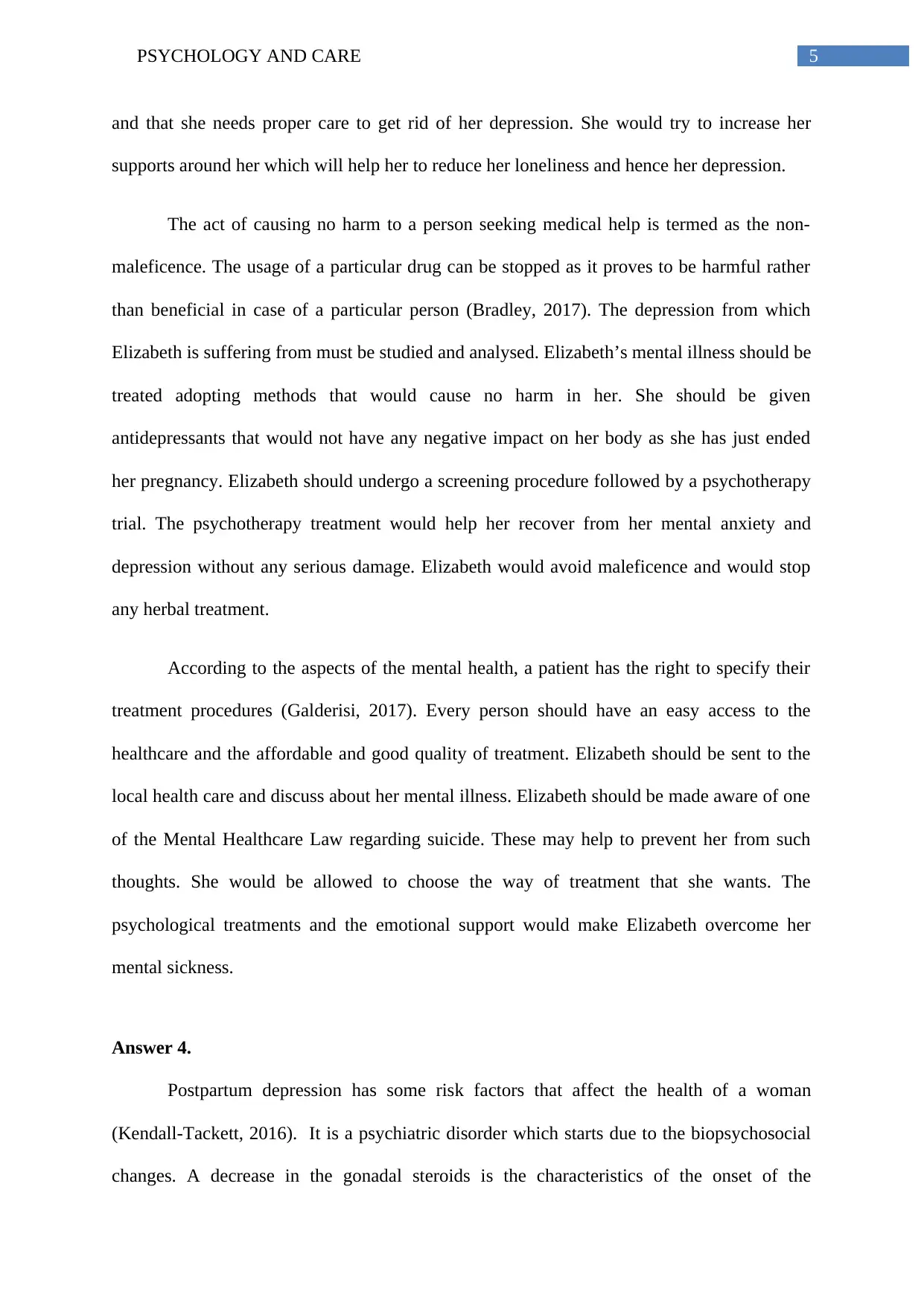
5PSYCHOLOGY AND CARE
and that she needs proper care to get rid of her depression. She would try to increase her
supports around her which will help her to reduce her loneliness and hence her depression.
The act of causing no harm to a person seeking medical help is termed as the non-
maleficence. The usage of a particular drug can be stopped as it proves to be harmful rather
than beneficial in case of a particular person (Bradley, 2017). The depression from which
Elizabeth is suffering from must be studied and analysed. Elizabeth’s mental illness should be
treated adopting methods that would cause no harm in her. She should be given
antidepressants that would not have any negative impact on her body as she has just ended
her pregnancy. Elizabeth should undergo a screening procedure followed by a psychotherapy
trial. The psychotherapy treatment would help her recover from her mental anxiety and
depression without any serious damage. Elizabeth would avoid maleficence and would stop
any herbal treatment.
According to the aspects of the mental health, a patient has the right to specify their
treatment procedures (Galderisi, 2017). Every person should have an easy access to the
healthcare and the affordable and good quality of treatment. Elizabeth should be sent to the
local health care and discuss about her mental illness. Elizabeth should be made aware of one
of the Mental Healthcare Law regarding suicide. These may help to prevent her from such
thoughts. She would be allowed to choose the way of treatment that she wants. The
psychological treatments and the emotional support would make Elizabeth overcome her
mental sickness.
Answer 4.
Postpartum depression has some risk factors that affect the health of a woman
(Kendall-Tackett, 2016). It is a psychiatric disorder which starts due to the biopsychosocial
changes. A decrease in the gonadal steroids is the characteristics of the onset of the
and that she needs proper care to get rid of her depression. She would try to increase her
supports around her which will help her to reduce her loneliness and hence her depression.
The act of causing no harm to a person seeking medical help is termed as the non-
maleficence. The usage of a particular drug can be stopped as it proves to be harmful rather
than beneficial in case of a particular person (Bradley, 2017). The depression from which
Elizabeth is suffering from must be studied and analysed. Elizabeth’s mental illness should be
treated adopting methods that would cause no harm in her. She should be given
antidepressants that would not have any negative impact on her body as she has just ended
her pregnancy. Elizabeth should undergo a screening procedure followed by a psychotherapy
trial. The psychotherapy treatment would help her recover from her mental anxiety and
depression without any serious damage. Elizabeth would avoid maleficence and would stop
any herbal treatment.
According to the aspects of the mental health, a patient has the right to specify their
treatment procedures (Galderisi, 2017). Every person should have an easy access to the
healthcare and the affordable and good quality of treatment. Elizabeth should be sent to the
local health care and discuss about her mental illness. Elizabeth should be made aware of one
of the Mental Healthcare Law regarding suicide. These may help to prevent her from such
thoughts. She would be allowed to choose the way of treatment that she wants. The
psychological treatments and the emotional support would make Elizabeth overcome her
mental sickness.
Answer 4.
Postpartum depression has some risk factors that affect the health of a woman
(Kendall-Tackett, 2016). It is a psychiatric disorder which starts due to the biopsychosocial
changes. A decrease in the gonadal steroids is the characteristics of the onset of the
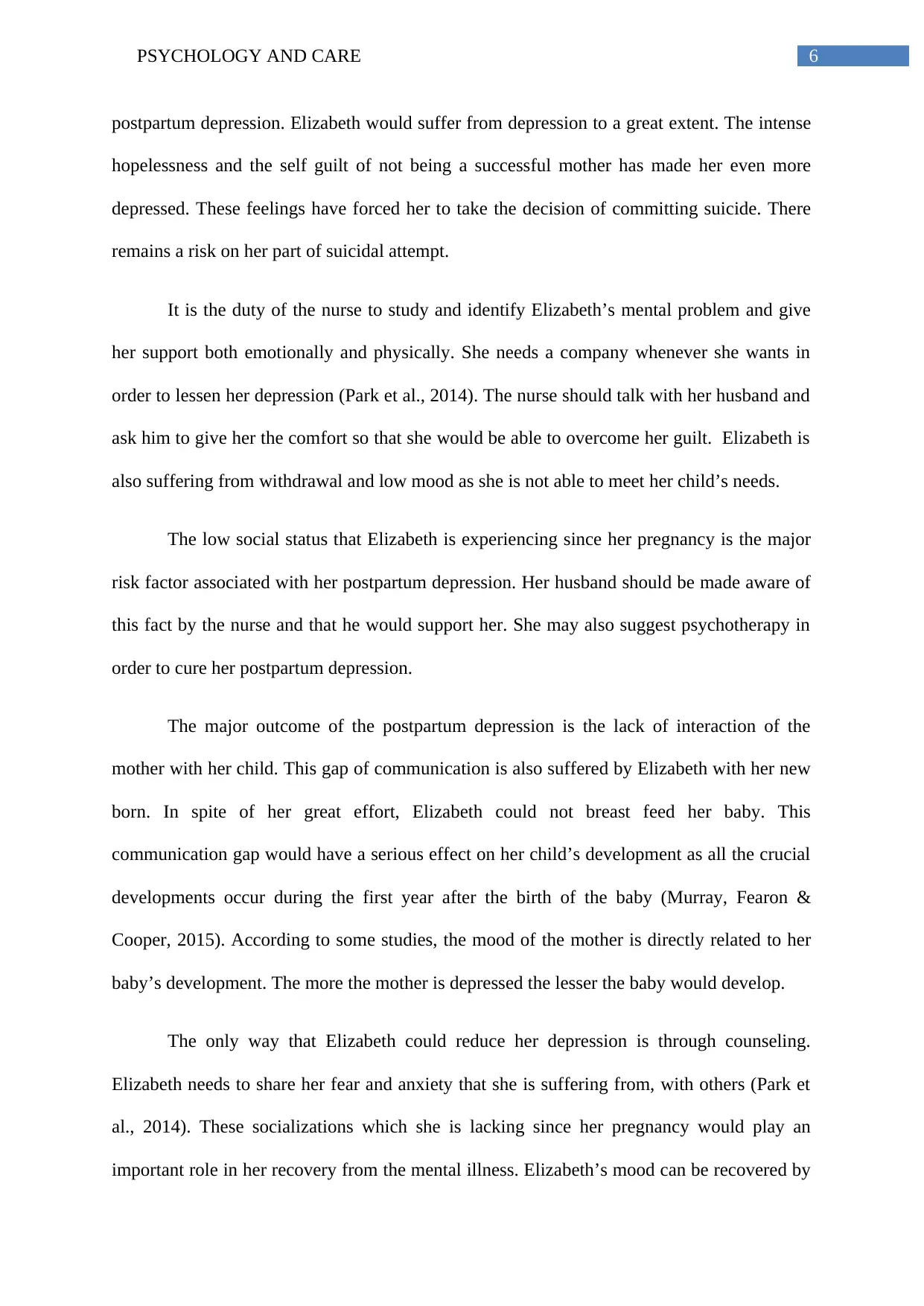
6PSYCHOLOGY AND CARE
postpartum depression. Elizabeth would suffer from depression to a great extent. The intense
hopelessness and the self guilt of not being a successful mother has made her even more
depressed. These feelings have forced her to take the decision of committing suicide. There
remains a risk on her part of suicidal attempt.
It is the duty of the nurse to study and identify Elizabeth’s mental problem and give
her support both emotionally and physically. She needs a company whenever she wants in
order to lessen her depression (Park et al., 2014). The nurse should talk with her husband and
ask him to give her the comfort so that she would be able to overcome her guilt. Elizabeth is
also suffering from withdrawal and low mood as she is not able to meet her child’s needs.
The low social status that Elizabeth is experiencing since her pregnancy is the major
risk factor associated with her postpartum depression. Her husband should be made aware of
this fact by the nurse and that he would support her. She may also suggest psychotherapy in
order to cure her postpartum depression.
The major outcome of the postpartum depression is the lack of interaction of the
mother with her child. This gap of communication is also suffered by Elizabeth with her new
born. In spite of her great effort, Elizabeth could not breast feed her baby. This
communication gap would have a serious effect on her child’s development as all the crucial
developments occur during the first year after the birth of the baby (Murray, Fearon &
Cooper, 2015). According to some studies, the mood of the mother is directly related to her
baby’s development. The more the mother is depressed the lesser the baby would develop.
The only way that Elizabeth could reduce her depression is through counseling.
Elizabeth needs to share her fear and anxiety that she is suffering from, with others (Park et
al., 2014). These socializations which she is lacking since her pregnancy would play an
important role in her recovery from the mental illness. Elizabeth’s mood can be recovered by
postpartum depression. Elizabeth would suffer from depression to a great extent. The intense
hopelessness and the self guilt of not being a successful mother has made her even more
depressed. These feelings have forced her to take the decision of committing suicide. There
remains a risk on her part of suicidal attempt.
It is the duty of the nurse to study and identify Elizabeth’s mental problem and give
her support both emotionally and physically. She needs a company whenever she wants in
order to lessen her depression (Park et al., 2014). The nurse should talk with her husband and
ask him to give her the comfort so that she would be able to overcome her guilt. Elizabeth is
also suffering from withdrawal and low mood as she is not able to meet her child’s needs.
The low social status that Elizabeth is experiencing since her pregnancy is the major
risk factor associated with her postpartum depression. Her husband should be made aware of
this fact by the nurse and that he would support her. She may also suggest psychotherapy in
order to cure her postpartum depression.
The major outcome of the postpartum depression is the lack of interaction of the
mother with her child. This gap of communication is also suffered by Elizabeth with her new
born. In spite of her great effort, Elizabeth could not breast feed her baby. This
communication gap would have a serious effect on her child’s development as all the crucial
developments occur during the first year after the birth of the baby (Murray, Fearon &
Cooper, 2015). According to some studies, the mood of the mother is directly related to her
baby’s development. The more the mother is depressed the lesser the baby would develop.
The only way that Elizabeth could reduce her depression is through counseling.
Elizabeth needs to share her fear and anxiety that she is suffering from, with others (Park et
al., 2014). These socializations which she is lacking since her pregnancy would play an
important role in her recovery from the mental illness. Elizabeth’s mood can be recovered by
Paraphrase This Document
Need a fresh take? Get an instant paraphrase of this document with our AI Paraphraser
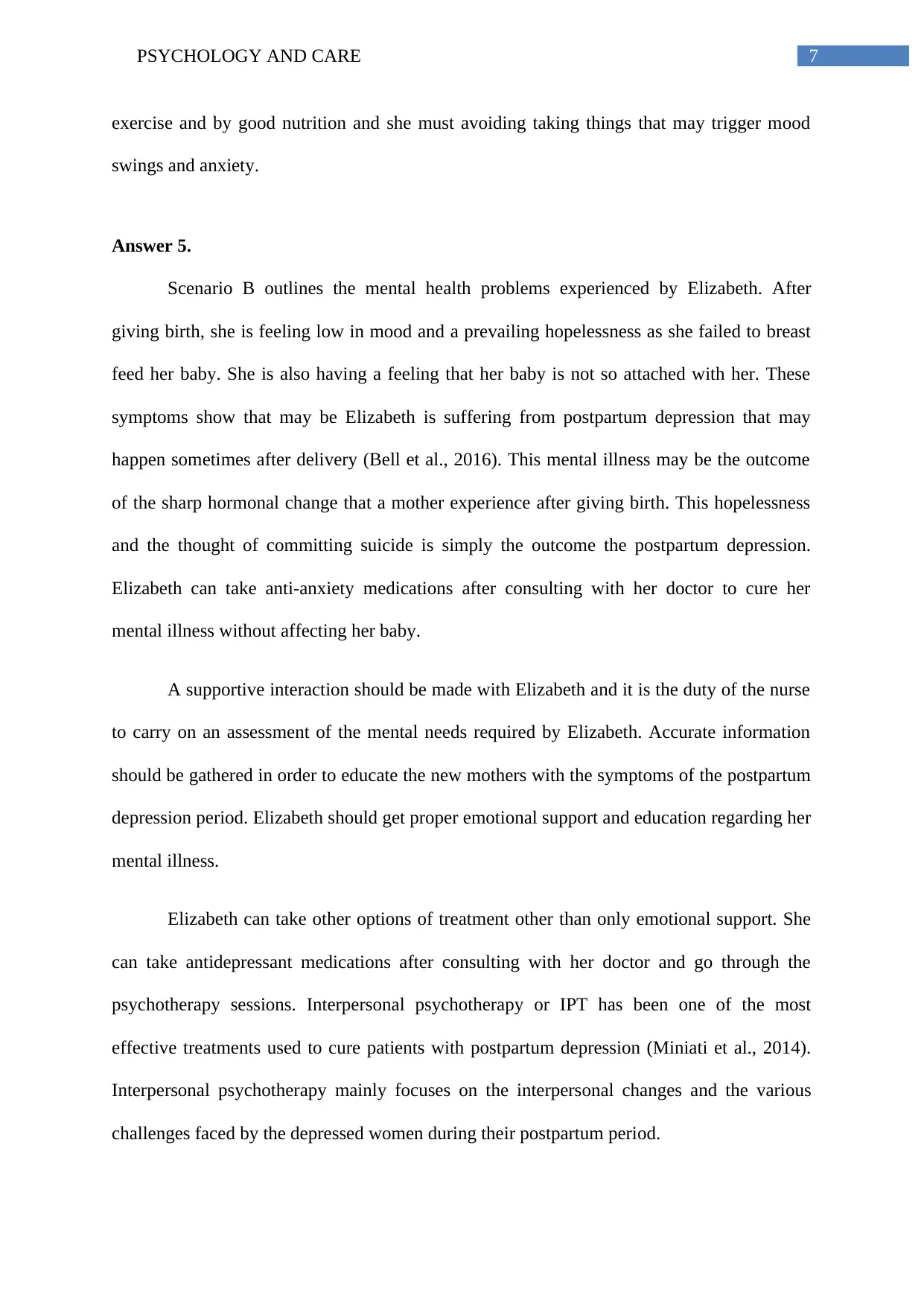
7PSYCHOLOGY AND CARE
exercise and by good nutrition and she must avoiding taking things that may trigger mood
swings and anxiety.
Answer 5.
Scenario B outlines the mental health problems experienced by Elizabeth. After
giving birth, she is feeling low in mood and a prevailing hopelessness as she failed to breast
feed her baby. She is also having a feeling that her baby is not so attached with her. These
symptoms show that may be Elizabeth is suffering from postpartum depression that may
happen sometimes after delivery (Bell et al., 2016). This mental illness may be the outcome
of the sharp hormonal change that a mother experience after giving birth. This hopelessness
and the thought of committing suicide is simply the outcome the postpartum depression.
Elizabeth can take anti-anxiety medications after consulting with her doctor to cure her
mental illness without affecting her baby.
A supportive interaction should be made with Elizabeth and it is the duty of the nurse
to carry on an assessment of the mental needs required by Elizabeth. Accurate information
should be gathered in order to educate the new mothers with the symptoms of the postpartum
depression period. Elizabeth should get proper emotional support and education regarding her
mental illness.
Elizabeth can take other options of treatment other than only emotional support. She
can take antidepressant medications after consulting with her doctor and go through the
psychotherapy sessions. Interpersonal psychotherapy or IPT has been one of the most
effective treatments used to cure patients with postpartum depression (Miniati et al., 2014).
Interpersonal psychotherapy mainly focuses on the interpersonal changes and the various
challenges faced by the depressed women during their postpartum period.
exercise and by good nutrition and she must avoiding taking things that may trigger mood
swings and anxiety.
Answer 5.
Scenario B outlines the mental health problems experienced by Elizabeth. After
giving birth, she is feeling low in mood and a prevailing hopelessness as she failed to breast
feed her baby. She is also having a feeling that her baby is not so attached with her. These
symptoms show that may be Elizabeth is suffering from postpartum depression that may
happen sometimes after delivery (Bell et al., 2016). This mental illness may be the outcome
of the sharp hormonal change that a mother experience after giving birth. This hopelessness
and the thought of committing suicide is simply the outcome the postpartum depression.
Elizabeth can take anti-anxiety medications after consulting with her doctor to cure her
mental illness without affecting her baby.
A supportive interaction should be made with Elizabeth and it is the duty of the nurse
to carry on an assessment of the mental needs required by Elizabeth. Accurate information
should be gathered in order to educate the new mothers with the symptoms of the postpartum
depression period. Elizabeth should get proper emotional support and education regarding her
mental illness.
Elizabeth can take other options of treatment other than only emotional support. She
can take antidepressant medications after consulting with her doctor and go through the
psychotherapy sessions. Interpersonal psychotherapy or IPT has been one of the most
effective treatments used to cure patients with postpartum depression (Miniati et al., 2014).
Interpersonal psychotherapy mainly focuses on the interpersonal changes and the various
challenges faced by the depressed women during their postpartum period.
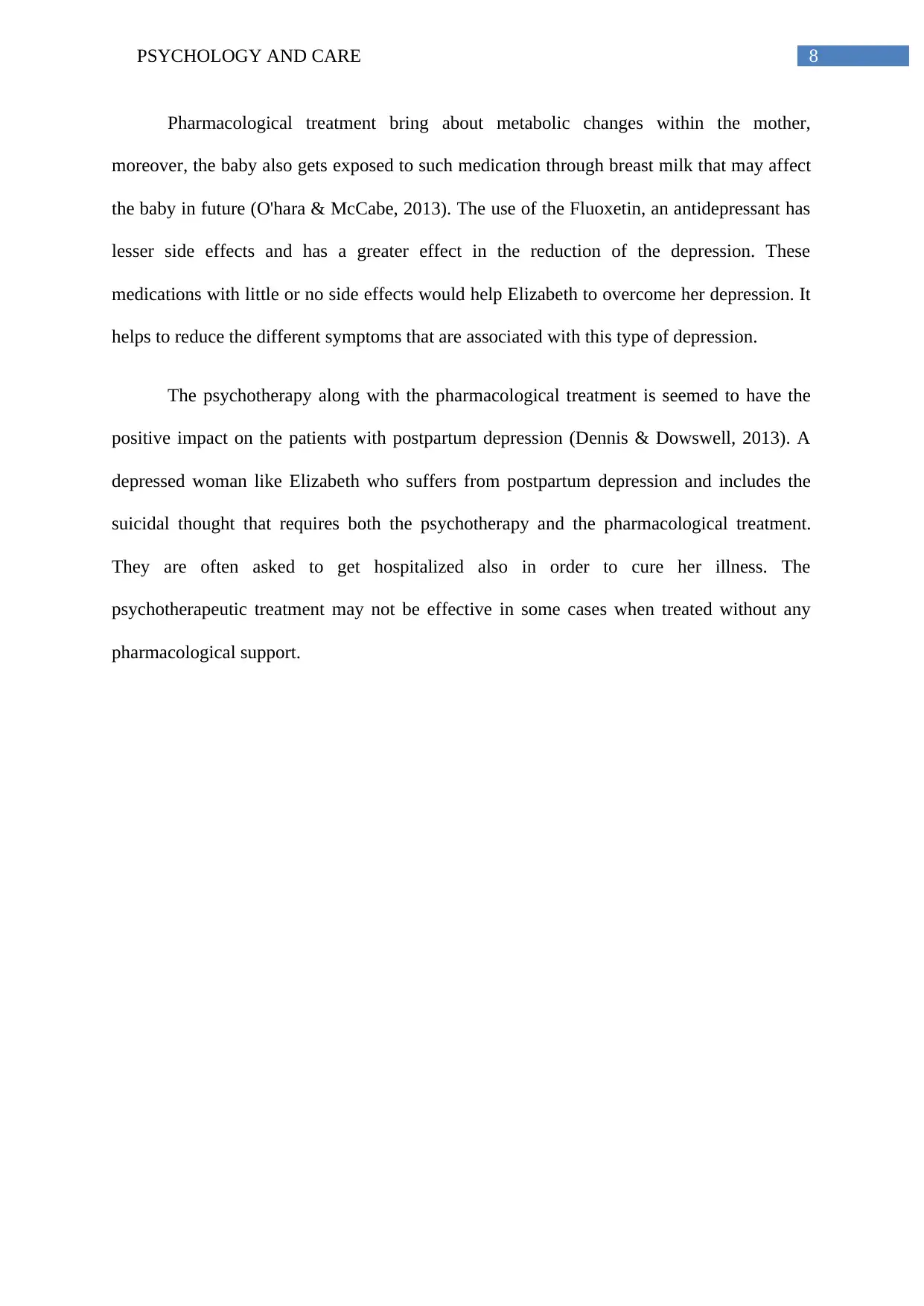
8PSYCHOLOGY AND CARE
Pharmacological treatment bring about metabolic changes within the mother,
moreover, the baby also gets exposed to such medication through breast milk that may affect
the baby in future (O'hara & McCabe, 2013). The use of the Fluoxetin, an antidepressant has
lesser side effects and has a greater effect in the reduction of the depression. These
medications with little or no side effects would help Elizabeth to overcome her depression. It
helps to reduce the different symptoms that are associated with this type of depression.
The psychotherapy along with the pharmacological treatment is seemed to have the
positive impact on the patients with postpartum depression (Dennis & Dowswell, 2013). A
depressed woman like Elizabeth who suffers from postpartum depression and includes the
suicidal thought that requires both the psychotherapy and the pharmacological treatment.
They are often asked to get hospitalized also in order to cure her illness. The
psychotherapeutic treatment may not be effective in some cases when treated without any
pharmacological support.
Pharmacological treatment bring about metabolic changes within the mother,
moreover, the baby also gets exposed to such medication through breast milk that may affect
the baby in future (O'hara & McCabe, 2013). The use of the Fluoxetin, an antidepressant has
lesser side effects and has a greater effect in the reduction of the depression. These
medications with little or no side effects would help Elizabeth to overcome her depression. It
helps to reduce the different symptoms that are associated with this type of depression.
The psychotherapy along with the pharmacological treatment is seemed to have the
positive impact on the patients with postpartum depression (Dennis & Dowswell, 2013). A
depressed woman like Elizabeth who suffers from postpartum depression and includes the
suicidal thought that requires both the psychotherapy and the pharmacological treatment.
They are often asked to get hospitalized also in order to cure her illness. The
psychotherapeutic treatment may not be effective in some cases when treated without any
pharmacological support.
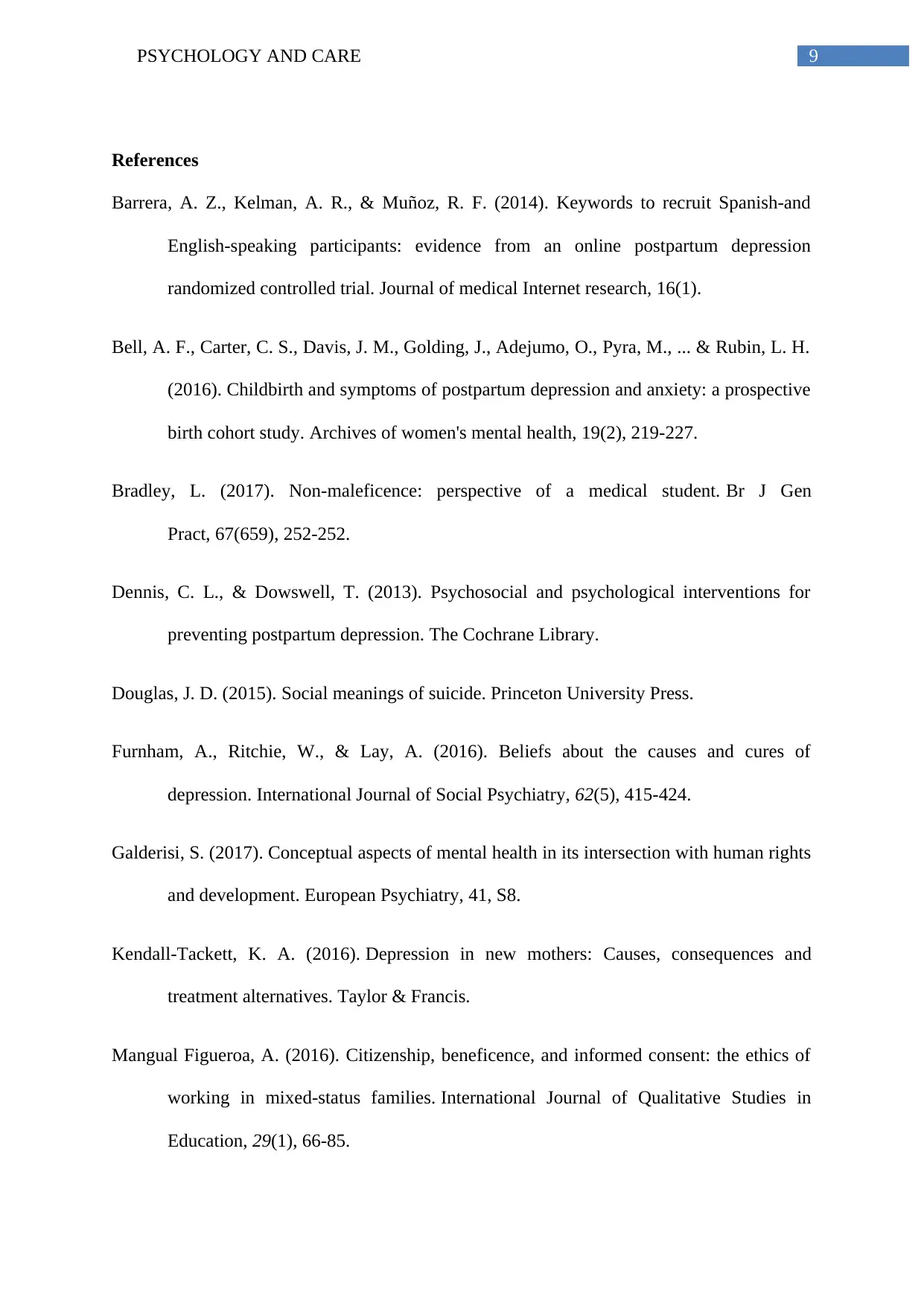
9PSYCHOLOGY AND CARE
References
Barrera, A. Z., Kelman, A. R., & Muñoz, R. F. (2014). Keywords to recruit Spanish-and
English-speaking participants: evidence from an online postpartum depression
randomized controlled trial. Journal of medical Internet research, 16(1).
Bell, A. F., Carter, C. S., Davis, J. M., Golding, J., Adejumo, O., Pyra, M., ... & Rubin, L. H.
(2016). Childbirth and symptoms of postpartum depression and anxiety: a prospective
birth cohort study. Archives of women's mental health, 19(2), 219-227.
Bradley, L. (2017). Non-maleficence: perspective of a medical student. Br J Gen
Pract, 67(659), 252-252.
Dennis, C. L., & Dowswell, T. (2013). Psychosocial and psychological interventions for
preventing postpartum depression. The Cochrane Library.
Douglas, J. D. (2015). Social meanings of suicide. Princeton University Press.
Furnham, A., Ritchie, W., & Lay, A. (2016). Beliefs about the causes and cures of
depression. International Journal of Social Psychiatry, 62(5), 415-424.
Galderisi, S. (2017). Conceptual aspects of mental health in its intersection with human rights
and development. European Psychiatry, 41, S8.
Kendall-Tackett, K. A. (2016). Depression in new mothers: Causes, consequences and
treatment alternatives. Taylor & Francis.
Mangual Figueroa, A. (2016). Citizenship, beneficence, and informed consent: the ethics of
working in mixed-status families. International Journal of Qualitative Studies in
Education, 29(1), 66-85.
References
Barrera, A. Z., Kelman, A. R., & Muñoz, R. F. (2014). Keywords to recruit Spanish-and
English-speaking participants: evidence from an online postpartum depression
randomized controlled trial. Journal of medical Internet research, 16(1).
Bell, A. F., Carter, C. S., Davis, J. M., Golding, J., Adejumo, O., Pyra, M., ... & Rubin, L. H.
(2016). Childbirth and symptoms of postpartum depression and anxiety: a prospective
birth cohort study. Archives of women's mental health, 19(2), 219-227.
Bradley, L. (2017). Non-maleficence: perspective of a medical student. Br J Gen
Pract, 67(659), 252-252.
Dennis, C. L., & Dowswell, T. (2013). Psychosocial and psychological interventions for
preventing postpartum depression. The Cochrane Library.
Douglas, J. D. (2015). Social meanings of suicide. Princeton University Press.
Furnham, A., Ritchie, W., & Lay, A. (2016). Beliefs about the causes and cures of
depression. International Journal of Social Psychiatry, 62(5), 415-424.
Galderisi, S. (2017). Conceptual aspects of mental health in its intersection with human rights
and development. European Psychiatry, 41, S8.
Kendall-Tackett, K. A. (2016). Depression in new mothers: Causes, consequences and
treatment alternatives. Taylor & Francis.
Mangual Figueroa, A. (2016). Citizenship, beneficence, and informed consent: the ethics of
working in mixed-status families. International Journal of Qualitative Studies in
Education, 29(1), 66-85.
Secure Best Marks with AI Grader
Need help grading? Try our AI Grader for instant feedback on your assignments.
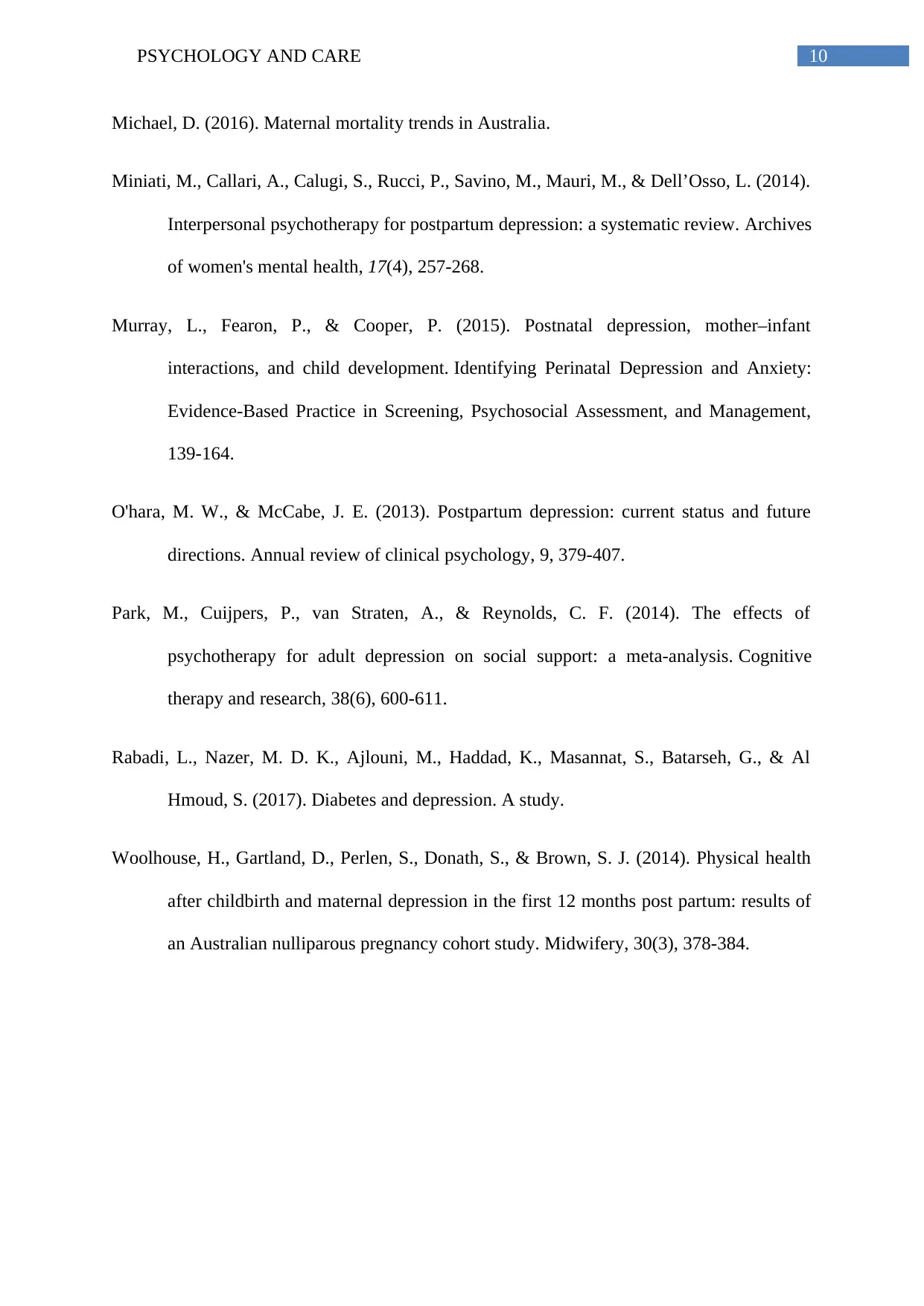
10PSYCHOLOGY AND CARE
Michael, D. (2016). Maternal mortality trends in Australia.
Miniati, M., Callari, A., Calugi, S., Rucci, P., Savino, M., Mauri, M., & Dell’Osso, L. (2014).
Interpersonal psychotherapy for postpartum depression: a systematic review. Archives
of women's mental health, 17(4), 257-268.
Murray, L., Fearon, P., & Cooper, P. (2015). Postnatal depression, mother–infant
interactions, and child development. Identifying Perinatal Depression and Anxiety:
Evidence-Based Practice in Screening, Psychosocial Assessment, and Management,
139-164.
O'hara, M. W., & McCabe, J. E. (2013). Postpartum depression: current status and future
directions. Annual review of clinical psychology, 9, 379-407.
Park, M., Cuijpers, P., van Straten, A., & Reynolds, C. F. (2014). The effects of
psychotherapy for adult depression on social support: a meta-analysis. Cognitive
therapy and research, 38(6), 600-611.
Rabadi, L., Nazer, M. D. K., Ajlouni, M., Haddad, K., Masannat, S., Batarseh, G., & Al
Hmoud, S. (2017). Diabetes and depression. A study.
Woolhouse, H., Gartland, D., Perlen, S., Donath, S., & Brown, S. J. (2014). Physical health
after childbirth and maternal depression in the first 12 months post partum: results of
an Australian nulliparous pregnancy cohort study. Midwifery, 30(3), 378-384.
Michael, D. (2016). Maternal mortality trends in Australia.
Miniati, M., Callari, A., Calugi, S., Rucci, P., Savino, M., Mauri, M., & Dell’Osso, L. (2014).
Interpersonal psychotherapy for postpartum depression: a systematic review. Archives
of women's mental health, 17(4), 257-268.
Murray, L., Fearon, P., & Cooper, P. (2015). Postnatal depression, mother–infant
interactions, and child development. Identifying Perinatal Depression and Anxiety:
Evidence-Based Practice in Screening, Psychosocial Assessment, and Management,
139-164.
O'hara, M. W., & McCabe, J. E. (2013). Postpartum depression: current status and future
directions. Annual review of clinical psychology, 9, 379-407.
Park, M., Cuijpers, P., van Straten, A., & Reynolds, C. F. (2014). The effects of
psychotherapy for adult depression on social support: a meta-analysis. Cognitive
therapy and research, 38(6), 600-611.
Rabadi, L., Nazer, M. D. K., Ajlouni, M., Haddad, K., Masannat, S., Batarseh, G., & Al
Hmoud, S. (2017). Diabetes and depression. A study.
Woolhouse, H., Gartland, D., Perlen, S., Donath, S., & Brown, S. J. (2014). Physical health
after childbirth and maternal depression in the first 12 months post partum: results of
an Australian nulliparous pregnancy cohort study. Midwifery, 30(3), 378-384.
1 out of 11
Related Documents
Your All-in-One AI-Powered Toolkit for Academic Success.
+13062052269
info@desklib.com
Available 24*7 on WhatsApp / Email
![[object Object]](/_next/static/media/star-bottom.7253800d.svg)
Unlock your academic potential
© 2024 | Zucol Services PVT LTD | All rights reserved.





